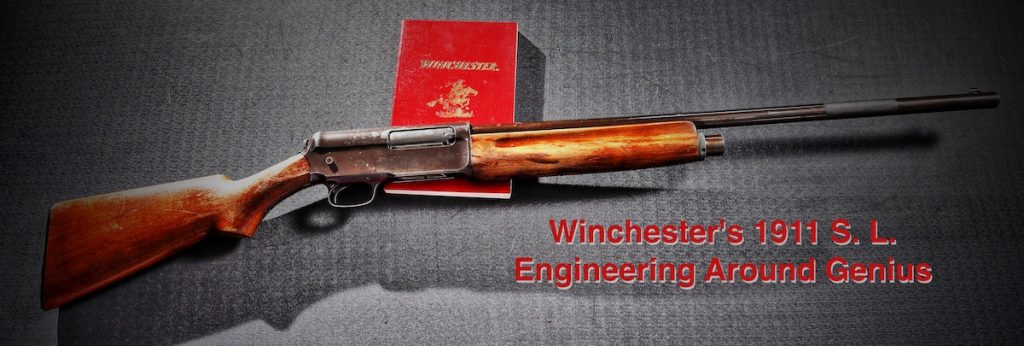 Way back when, “A man’s word was his bond.” But, in 1901 the bond between two powerhouses in the firearms industry was broken. T.G. Bennet, President of Winchester, and John M. Browning (JMB) had come to an impasse over how JMB would be compensated for his latest creation: the Auto 5 shotgun.
Way back when, “A man’s word was his bond.” But, in 1901 the bond between two powerhouses in the firearms industry was broken. T.G. Bennet, President of Winchester, and John M. Browning (JMB) had come to an impasse over how JMB would be compensated for his latest creation: the Auto 5 shotgun.
Perhaps it was T.G. Bennet’s failure to foresee that the world’s first reliable self-loading shotgun would be a hit with Winchester consumers. Or maybe it was John Browning’s demands for “royalties” on this gun, rather than selling it outright as he had done with every other gun for the previous 17 years. Either way, the two men parted company, JMB leaving with his prototype and all of its patents and Winchester without a self-loading shotgun.
The Beginning
By 1902, Browning’s self-described “best achievement” is being produced by Fabrique Nationale in Belgium and by 1913 over 60,000 Auto 5’s have been sold! Meanwhile, T.G. Bennet is barking at his engineers to create a shotgun to compete with the Auto 5! Now here is where it gets really interesting. Remember that I said the JMB left with all the patents? While Winchester did pay outright for Browning’s gun designs, they also researched and filed all the design patents in JMB’s name! Try building a lever gun without a lever or a revolver without a cylinder and you might get an idea of what Winchester engineers were facing trying work around JMB’s patents!

Winchester 1911 SL Long Action compared to the Auto 5
One of the design elements that did make it into the Winchester 1911 SL (and several other shotguns, rifles, and even pistols) is its “Long Recoil” system. In operation the barrel and bolt lock together under recoil as they move rearward, compressing a recoil spring until stopped by the receiver.
At this point, the bolt remains in place as the barrel returns forward. While most guns with which we are familiar extract the hull from the chamber, in this set-up the chamber moves away from the hull. An ejector is fixed to the barrel extension and as the barrel moves forward the ejector makes contact with the hull’s rim driving it from the gun. If the gun is empty the bolt will remain locked to the rear, if a fresh shell is released from the magazine tube it will trip the bolt allowing it to move forward powered by the action spring, thus chambering that shell.
Some Oddities
If we look at the gun as a stand-alone piece, the Winchester 1911 SL is an odd character. If you were to hand one to someone unfamiliar with it, one of the first comments would be, “How do I check the chamber?” or “Where is the bolt handle?” The answers are, “With some level of difficulty,” and “It doesn’t have one!”
To work around the bolt handle patent, the barrel is wrapped with a knurled section a few inches back from the muzzle. Being very careful to have the muzzle pointed in a safe direction, one pulls back on the barrel some 3” in order to cycle the bolt fully to the rear. This “feature” has been called a “widow-maker” as it is rumored that some halfwit discharged the gun while cycling the barrel to the rear with the butt of the gun on the ground and the muzzle pointed at his face. Personally, I don’t believe it (or maybe I do if half the dopes on the internet actually own guns).

Top: Browing Auto 5 Bottom: Winchester 1911 SL
Another oddity is the front sight. Now, on just about every shotgun I have handled a bead is present unless it is a dedicated slug or 3-gun unit where a rifle sight may be present. However, the funky looking appendage on the front of the 1911 SL is nearly magic. From about any angle it looks out of place, but when sighting down the gun as if to fire…a bead front sight appears!
Take-Down Guns
“Take-down” guns are not a new thing as witnessed in this 100-year-old gun. That lone screw at the rear of the receiver? Yup, depress that screw’s lock button and spin ‘er out and pop! Off come the buttstock and trigger assembly, fire control and all! Ok, that is kinda cool, but how about the fact that you can fully load the magazine and chamber a round and then pop the gun into 2 pieces? Couple that with the ability to shorten the barrel to flush with the end of the magazine tube without impairing reliability and you have me picturing this gun being used in a crime novel. I know that my buddy Clay Martin could weave this into another really cool book!
Now, if the only two weird features were the funny front sight, and charging the gun by grabbing and “cycling” the barrel, the gun would be ok. But the biggest JMB patent item that Winchester engineers could not get around led to the demise of the 1911 SL after a few short years of production.
Browning’s Patent

Winchester 1911 SL Buffer vs. Friction Brake of the A5
Browning’s patent on the Long Recoil Action “Friction-Brake” and Winchester’s awkward substitute for that vital element had the 1911 SL on life support from the get go! Take a look at the photos and you will see the heart of the Auto 5 and the band-aid on the 1911 SL. Present on the Auto 5 is a little bronze ring with its beveled edges and a barrel hangar and washer with corresponding internal bevels. As all that mass of the barrel breech block moves rearward under recoil those “bevels” constrict the friction brake around the magazine tube. The friction brake dragging on the magazine tube slows the works down a bit and that greatly reduces the impact of a couple of pounds of reciprocating weight banging into the receiver! It was that simple and elegant design that kept the Auto 5 humming along while the 1911 SL beat itself and its owners into submission.
Recoil

The Winchester 1911 SL had to use a laminate stock because the conventional stocks would splinter and crack!
Winchester tried to mitigate the pounding of “man and machine” by employing a pair of fiber buffers between the incoming barrel “battering ram” and the face of the receiver. I imagine it was better than nothing, but not enough to save the gun. In fact, one of the cool “features” of the 1911 SL needed to combat the beastly recoil was the first commercial use of a wood laminate in the buttstock! Why? Because the conventional stocks would splinter and crack! Necessity is the mother of invention. Another notable unhealthy design element on the 1911 SL was the action spring “running free” inside the wood buttstock rather than captured in a steel tube as on the Auto 5. I can tell you the resulting wood shavings don’t work so well as a lubricant.

The Winchester 1911 SL’s action spring “running free” inside the wood buttstock rather than captured in a steel tube as on the Auto 5.
So after 14 of years and fewer than 83,000 Winchester 1911SLs produced (including some beautiful Trap Models), the buying public had had enough. While the Browning Auto5 and JMB’s brilliant Long Recoil Action soldier on for better than 6 decades, Winchester’s efforts to engineer around genius was dropped into the dustbin of history.
I can’t help but wonder about the outcome if T.G. and JMB had worked things out. If JMB got his deal? If Winchester had built the Auto 5? Certainly, both men would have been all the richer, but Browning would never have seen his name engraved on the side of his Best Achievement. As a collector of many JMB designs (including several Auto 5’s) I am pleased that Browning’s name is emblazoned where it belongs.
For more information about Winchester firearms, click here.
